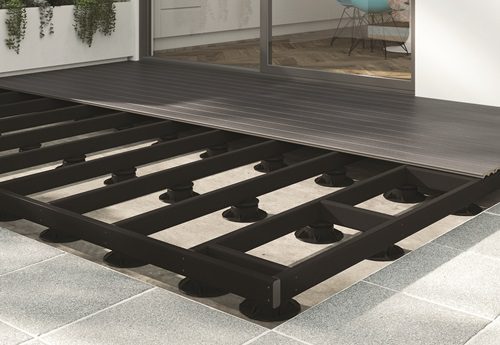A good quality, solid decking base is critical to ensuring your composite decking looks great and is safe and structurally-sound for many years to come. However laying the right deck surface and selecting the best subframe materials often gets overlooked!
In this blog we’ll cover everything you need to know about composite decking bases, from choosing the right surface for your base, to selecting the most appropriate subframe.
What is a composite decking frame?
Correctly installed composite decking should sit on a subframe. This can be made from a variety of materials and is traditionally made-up of joists that form an outer frame, bearers and noggins that are used for supports, and posts that go into the ground. There’s lots to consider when building your composite frame, from joist and post spacing, to the height of your frame. More tips about building your base can be found here and you should consult your decking installation instructions, as best practice will vary from manufacturer to manufacturer.
Choosing the right surface for your decking base
Before laying your composite decking, it’s essential to prepare the ground underneath to ensure stability and longevity. The surface that your decking base will sit on plays a crucial role in preventing issues such as shifting, sinking, or warping over time. Different types of decking may need specific requirements, wide PVC decking for example.
The three most common surface options are:
1. Slabs
Slabs of any kind are an ideal surface for composite decking. They’re stable, durable, and provide excellent support. You may already have patio slabs laid that you want to cover with decking – don’t get them up – they’re the perfect base for decking.
If laying your decking on slabs it’s often best to use decking pedestals (see more below) as their height can be adjusted to ensure a perfectly level subframe, even if your slabs are a little wonky.
2. Concrete
Laying concrete is also an ideal surface for composite decking, for the same reasons as above e.g it provides a strong, level base.
3. Compacted soil or gravel
You can create a stable base using compacted soil and a layer of gravel. Start by removing any vegetation and levelling the ground. Then, add a layer of gravel and compact it thoroughly. This setup provides good drainage and a solid foundation.
If you’re building your deck over soil, using timber posts are a viable option, as they can be driven into the ground and the joists can be sat on top (see below for more information).
Whichever surface you decide upon, you’ll need to prepare the ground before laying your decking, including removing any weeds and plants and laying a membrane to stop further growth.
What material should I use to build my composite decking base?
The subframe of your composite decking can be made from a number of different materials. The most common are timber, composite wood or aluminium.
The material you choose will be dependent on:
- The location of your decking
- The height of your decking
- The decking load
- Your budget
Here’s a quick overview of each material and their pros and cons:
Timber
A timber frame is the most common type to support you decking boards. Whilst strong and relatively long lasting, it’s advisable to use pressure-treated timber so it’s less likely to rot, decay and succumb to insect damage. Over time, however, timber will likely warp and twist, which can be detrimental to the safety of the frame.

Composite
Composite deck frames are fast becoming one of the most popular choices for decking bases. As with composite deck boards, composite joists and posts require no protective treatments or paints. They will not rot, split, or splinter and are extremely durable, providing you with an extremely long lasting subframe. Composite joists are also environmentally friendly, as they are often made from recycled materials.

Aluminium
Aluminium subframes offer a viable alternative to traditional timber. Some aluminium joists and posts will also be fire rated, making them ideal for use in high rise buildings. Whilst the most expensive option, they are light-weight and extremely long-lasting.
Composite decking pedestals or posts?
Timber or composite posts are often used when a decking subframe sits on a soil or gravel base. Posts can be bought in long lengths and cut down to fit the right height for the deck.
If installing decking onto concrete, a patio or a roof terrace, composite decking pedestals are an ideal alternative to using posts. Height adjustable pedestals make installation much quicker and ensure that your decking is level to prevent water pooling and ensure a long-lasting installation.
How Ecodek can help with your composite decking needs?
Here at Ecodek we are composite decking experts. From base to surface, our experts can help you build the best deck for you and your home. Call our friendly, knowledgeable team today on 01978 667 840 or email enquiries@ecodek.co.uk for a no obligation chat.
